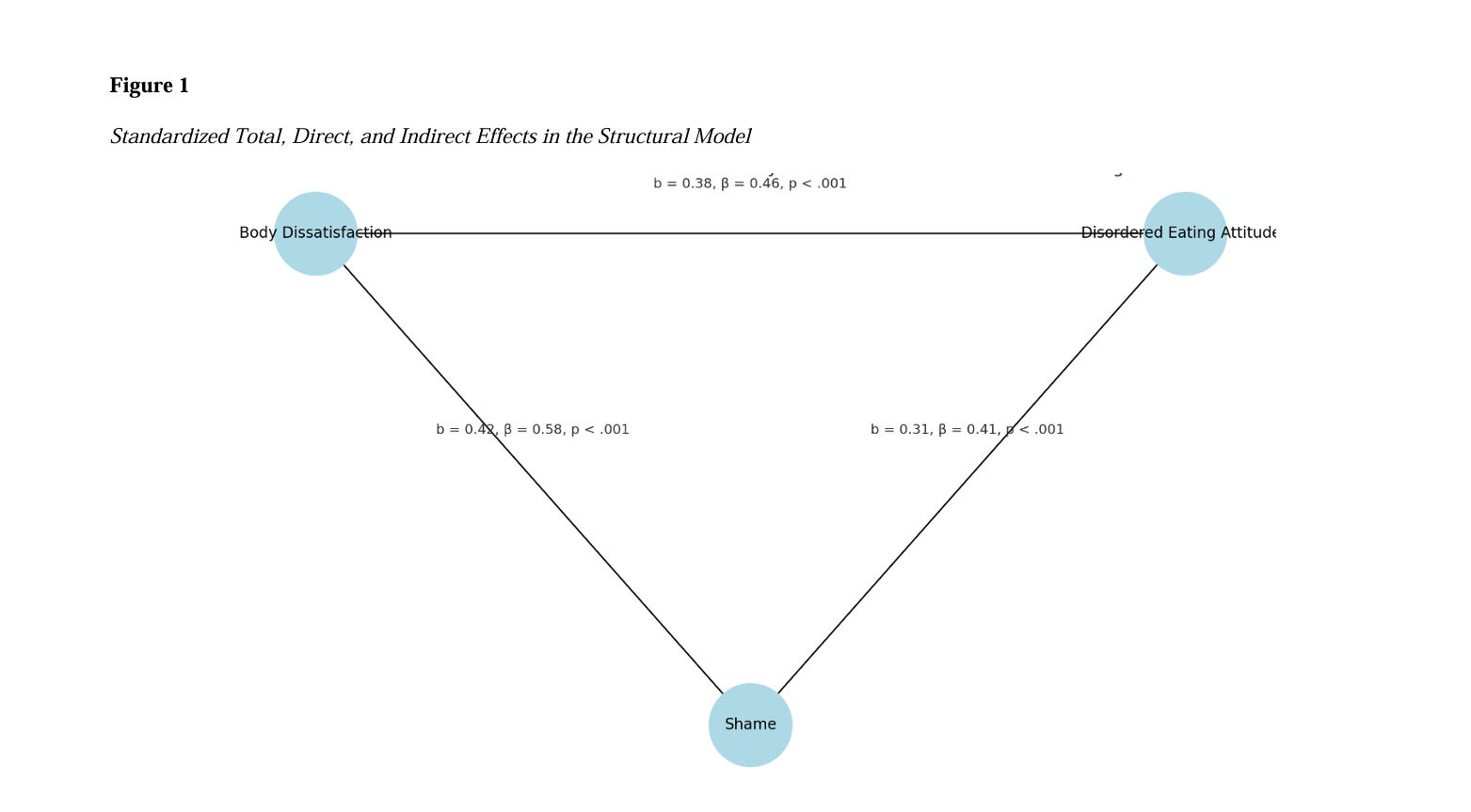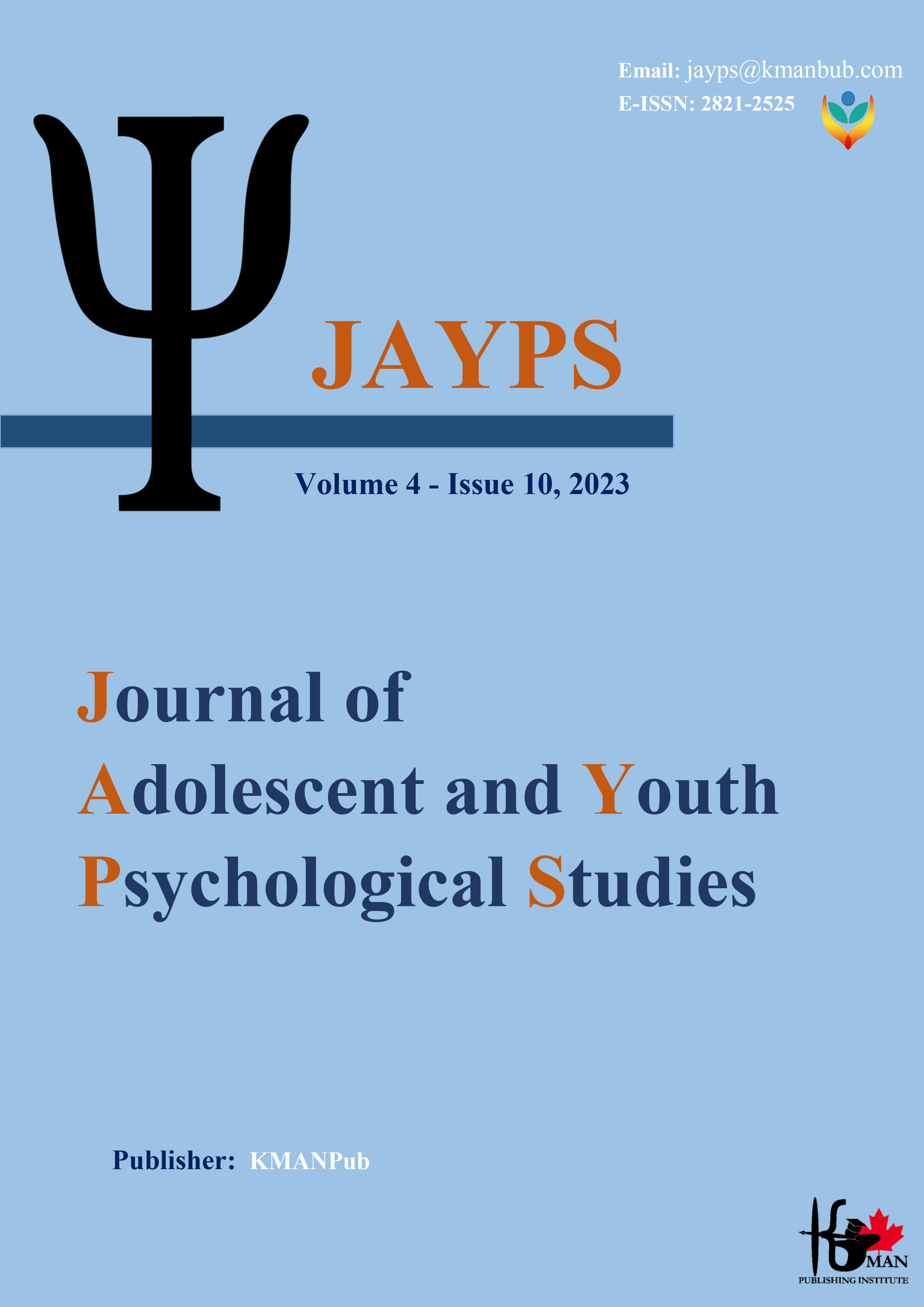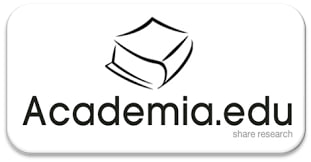Shame as a Mediator Between Body Dissatisfaction and Disordered Eating Attitudes
Keywords:
Body dissatisfaction, Shame, Disordered eating attitudesAbstract
Objective: This study aimed to investigate the mediating role of shame in the relationship between body dissatisfaction and disordered eating attitudes among Canadian adolescents and young adults.
Methods and Materials: A descriptive correlational design was employed with a sample of 400 participants aged 16 to 30 years, selected based on the Morgan and Krejcie sample size table. Participants were recruited from across Canada and completed standardized questionnaires, including the Body Shape Questionnaire (BSQ-34), the Experience of Shame Scale (ESS), and the Eating Attitudes Test-26 (EAT-26). Data were analyzed using SPSS-27 for descriptive statistics and Pearson correlation coefficients, and AMOS-21 was used to perform structural equation modeling (SEM) to examine both direct and indirect pathways between the study variables.
Findings: Descriptive statistics showed high mean scores for body dissatisfaction (M = 92.36, SD = 18.47), shame (M = 71.84, SD = 15.22), and disordered eating attitudes (M = 24.57, SD = 9.13). Pearson correlation results indicated significant positive relationships between body dissatisfaction and shame (r = .58, p < .001), body dissatisfaction and disordered eating attitudes (r = .63, p < .001), and shame and disordered eating attitudes (r = .56, p < .001). SEM results revealed a good model fit (χ²/df = 2.11, CFI = 0.97, RMSEA = 0.052). Shame significantly mediated the relationship between body dissatisfaction and disordered eating attitudes (indirect effect: b = 0.13, β = 0.24, p < .001), while the direct path remained significant (b = 0.38, β = 0.46, p < .001), indicating partial mediation.
Conclusion: The findings highlight shame as a significant emotional mechanism that partially explains the relationship between body dissatisfaction and disordered eating attitudes. Addressing shame in prevention and intervention efforts may be crucial in reducing disordered eating among adolescents and young adults experiencing body image concerns.
Downloads
References
Aleksić‐Veljković, A., Đurović, D., Biro, F., Stojanović, K., & Ilić, P. (2020). Eating Attitudes and Body Image Concerns Among Female Athletes From Aesthetic Sports. Annales Kinesiologiae, 3-16. https://doi.org/10.35469/ak.2020.242
Barnhart, W. R., Xiao, Y., Li, Y., Gaggiano, C. M., Jiang, Z., Wu, S., Cao, H., & He, J. (2024). Beyond Age, BMI, Gender Identity, and Gender Minority Stress, Weight Bias Internalization Is Uniquely Associated With More Eating and Body Image Disturbances and Poor Physical and Mental Health in Chinese Gender‐Diverse Adults. International Journal of Eating Disorders, 57(11), 2246-2259. https://doi.org/10.1002/eat.24278
Czepczor‐Bernat, K., Modrzejewska, J., Modrzejewska, A., Calandri, E., Gattino, S., & Rollero, C. (2022). Dyadic Predictors of Child Body Shame in a Polish and Italian Sample. International journal of environmental research and public health, 19(14), 8659. https://doi.org/10.3390/ijerph19148659
David, L. T. (2024). Objectification and Physical Appearance in Adolescent Girls. Series Vii - Social Sciences and Law, 209-218. https://doi.org/10.31926/but.ssl.2024.17.66.2.2
Ebrahim, M., Alkazemi, D., Zafar, T. A., & Kubow, S. (2019). Disordered Eating Attitudes Correlate With Body Dissatisfaction Among Kuwaiti Male College Students. Journal of eating disorders, 7(1). https://doi.org/10.1186/s40337-019-0265-z
Köse, G., & Tayfur, M. (2021). BMI, physical activity, sleep quality, eating attitudes, emotions: which one is affected by mindful eating? https://acikerisim.kent.edu.tr/xmlui/handle/20.500.12780/201
Kulshreshtha, M., Babu, N., Goel, N. J., & Chandel, S. (2020). Disordered Eating Attitudes and Body Shape Concerns Among North Indian Kathak Dancers. International Journal of Eating Disorders, 54(2), 148-154. https://doi.org/10.1002/eat.23425
Lestari, H., Hutahaean, E. S. H., & Fahrudin, A. (2023). Body Image Dissatisfaction in Body Shaming Victims. Kesans International Journal of Health and Science, 3(1), 22-29. https://doi.org/10.54543/kesans.v3i1.229
Linde, J., Luoma, J. B., Rück, C., Ramnerö, J., & Lundgren, T. (2023). Acceptance and compassion-based therapy targeting shame in body dysmorphic disorder: A multiple baseline study. Behavior Modification, 47(3), 693-718. https://doi.org/10.1177/01454455221129989
MacDonald, D. E. (2021). An Experimental Investigation of Body Displacement Theory in Restrained Eaters. https://doi.org/10.32920/ryerson.14650050.v1
Mbabazi, J., Nalweyiso, D. I., MacGregor, F., Breckon, J., Kunonga, E., Tolchard, B., Dawson, R., Teke, J., Bettany‐Saltikov, J., Kagugube, G. W., & Nnyanzi, L. A. (2023). A Qualitative Study of the Experiences of Obesity, Body Image, and Mental Health of British-Born Afro-Caribbean Male Students at a West Yorkshire University in England. International Journal of Physical Activity and Health. https://doi.org/10.18122/ijpah.020304.boisestate
Mendes, A. L., Ferreira, C., & Marta‐Simões, J. (2016). Experiential Avoidance Versus Decentering Abilities: The Role of Different Emotional Processes on Disordered Eating. Eating and Weight Disorders - Studies on Anorexia Bulimia and Obesity, 22(3), 467-474. https://doi.org/10.1007/s40519-016-0291-7
Navadiya, K., Rafi, S., Harvansh, B., Shamatmika, R., & Sharma, V. K. (2024). How Social Media Impacts Promotion of Body Image Dissatisfaction Among Youth. International Journal of Innovative Science and Research Technology, 3257-3281. https://doi.org/10.38124/ijisrt/ijisrt24jul1874
Olatona, F. A., Kolanisi, U., & Onselen, A. V. (2024). Body Image Dissatisfaction, Disordered Eating Attitudes and Nutritional Status Among Female Undergraduate Students in Lagos, Nigeria. African Journal of Food Agriculture Nutrition and Development, 24(2), 25426-25449. https://doi.org/10.18697/ajfand.127.23625
Pamies-Aubalat, L., Marcos, Y. Q., & Torregrosa, M. S. (2022). Psychosocial Profile Related to Disordered Eating Attitudes in Spanish Adolescents. Current Psychology, 42(23), 20193-20202. https://doi.org/10.1007/s12144-022-03164-1
Panero, M., Longo, P., Bacco, C. D., Abbate‐Daga, G., & Martini, M. (2022). Shame, Guilt, and Self-Consciousness in Anorexia Nervosa. Journal of clinical medicine, 11(22), 6683. https://doi.org/10.3390/jcm11226683
Riebel, M., Krasny-Pacini, A., Manolov, R., Rohmer, O., & Weiner, L. (2024). Compassion focused therapy for self-stigma and shame in autism: a single case pre-experimental study. Frontiers in Psychiatry, 14, 1281428. https://doi.org/10.3389/fpsyt.2023.1281428
Ryan, S., Ussher, J. M., & Hawkey, A. (2021). Managing the Premenstrual Body: A Body Mapping Study of Women’s Negotiation of Premenstrual Food Cravings and Exercise. Journal of eating disorders, 9(1). https://doi.org/10.1186/s40337-021-00478-6
Scoffier-Mériaux, S., & Paquet, Y. (2022). The Self-Regulation of Eating Attitudes in Sport Scale: Defining an Optimal Regulation Zone. Frontiers in psychology, 13. https://doi.org/10.3389/fpsyg.2022.905277
Shannen, T., Kang, S. R., & Kim, S. J. (2020). The Influence of Social Media Affinity on Eating Attitudes and Body Dissatisfaction in Philippine Adolescents. Child Health Nursing Research, 26(1), 121-129. https://doi.org/10.4094/chnr.2020.26.1.121
Thornborrow, T., Evans, E. H., Tovée, M. J., & Boothroyd, L. G. (2022). Sociocultural Drivers of Body Image and Eating Disorder Risk in Rural Nicaraguan Women. Journal of eating disorders, 10(1). https://doi.org/10.1186/s40337-022-00656-0
Tuan Nor Atiqah Syafiqah Tuan Abd, A., & Shukri, M. (2019). Relationship Between Body Dissatisfaction and Eating Disorder of University Students. Universiti Malaysia Terengganu Journal of Undergraduate Research, 1(2), 36-40. https://doi.org/10.46754/umtjur.v1i2.64
Türk, F., Kellett, S., & Waller, G. (2021). Determining the Potential Link of Self-Compassion With Eating Pathology and Body Image Among Women: A Longitudinal Mediational Study. Eating and Weight Disorders - Studies on Anorexia Bulimia and Obesity, 26(8), 2683-2691. https://doi.org/10.1007/s40519-021-01144-1
Uluyol, F. M. (2022). The Mediator Role of Femininity-Masculinity Perceptions Between Body Perception and Eating Attitudes. Klinik Psikoloji Dergisi(0), 1. https://doi.org/10.5455/kpd.26024438m000094
Vizin, G., Horváth, Z., Vankó, T., & Urbán, R. (2022). Body-Related Shame or Guilt? Dominant Factors in Maladaptive Eating Behaviors Among Hungarian and Norwegian University Students. Heliyon, 8(2), e08817. https://doi.org/10.1016/j.heliyon.2022.e08817
Zainab, W., Ahmed, S., Kumar, A., & Ali, S. (2023). The Effect of Body Dissatisfaction on Disordered Eating Attitudes: The Mediating Role of Negative Affects in Adolescents. J Pak Psychiatr Soc, 20(02). https://doi.org/10.63050/jpps.20.02.272
Zulkifli, C. N., Latif, N. A. A., & Idris, M. P. (2023). Body Shaming Among University Students: Awareness and Implications on the Body Image. International Journal of Academic Research in Business and Social Sciences, 13(2). https://doi.org/10.6007/ijarbss/v13-i2/16359

Downloads
Additional Files
Published
Submitted
Revised
Accepted
Issue
Section
License

This work is licensed under a Creative Commons Attribution-NonCommercial 4.0 International License.








